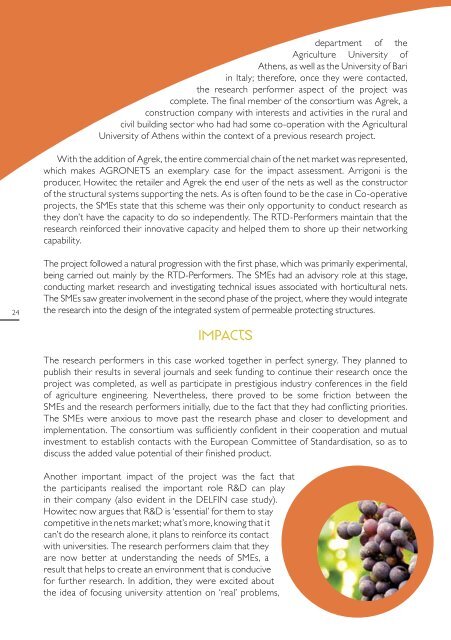SMEs and Research - European Commission - Europa
SMEs and Research - European Commission - Europa
SMEs and Research - European Commission - Europa
You also want an ePaper? Increase the reach of your titles
YUMPU automatically turns print PDFs into web optimized ePapers that Google loves.
24<br />
department of the<br />
Agriculture University of<br />
Athens, as well as the University of Bari<br />
in Italy; therefore, once they were contacted,<br />
the research performer aspect of the project was<br />
complete. The final member of the consortium was Agrek, a<br />
construction company with interests <strong>and</strong> activities in the rural <strong>and</strong><br />
civil building sector who had had some co-operation with the Agricultural<br />
University of Athens within the context of a previous research project.<br />
With the addition of Agrek, the entire commercial chain of the net market was represented,<br />
which makes AGRONETS an exemplary case for the impact assessment. Arrigoni is the<br />
producer, Howitec the retailer <strong>and</strong> Agrek the end user of the nets as well as the constructor<br />
of the structural systems supporting the nets. As is often found to be the case in Co-operative<br />
projects, the <strong>SMEs</strong> state that this scheme was their only opportunity to conduct research as<br />
they don’t have the capacity to do so independently. The RTD-Performers maintain that the<br />
research reinforced their innovative capacity <strong>and</strong> helped them to shore up their networking<br />
capability.<br />
The project followed a natural progression with the first phase, which was primarily experimental,<br />
being carried out mainly by the RTD-Performers. The <strong>SMEs</strong> had an advisory role at this stage,<br />
conducting market research <strong>and</strong> investigating technical issues associated with horticultural nets.<br />
The <strong>SMEs</strong> saw greater involvement in the second phase of the project, where they would integrate<br />
the research into the design of the integrated system of permeable protecting structures.<br />
IMPACTS<br />
The research performers in this case worked together in perfect synergy. They planned to<br />
publish their results in several journals <strong>and</strong> seek funding to continue their research once the<br />
project was completed, as well as participate in prestigious industry conferences in the field<br />
of agriculture engineering. Nevertheless, there proved to be some friction between the<br />
<strong>SMEs</strong> <strong>and</strong> the research performers initially, due to the fact that they had conflicting priorities.<br />
The <strong>SMEs</strong> were anxious to move past the research phase <strong>and</strong> closer to development <strong>and</strong><br />
implementation. The consortium was sufficiently confident in their cooperation <strong>and</strong> mutual<br />
investment to establish contacts with the <strong>European</strong> Committee of St<strong>and</strong>ardisation, so as to<br />
discuss the added value potential of their finished product.<br />
Another important impact of the project was the fact that<br />
the participants realised the important role R&D can play<br />
in their company (also evident in the DELFIN case study).<br />
Howitec now argues that R&D is ‘essential’ for them to stay<br />
competitive in the nets market; what’s more, knowing that it<br />
can’t do the research alone, it plans to reinforce its contact<br />
with universities. The research performers claim that they<br />
are now better at underst<strong>and</strong>ing the needs of <strong>SMEs</strong>, a<br />
result that helps to create an environment that is conducive<br />
for further research. In addition, they were excited about<br />
the idea of focusing university attention on ‘real’ problems,
















